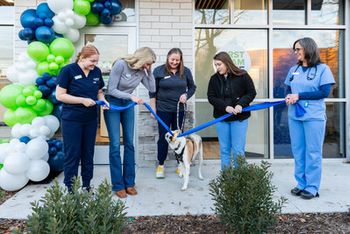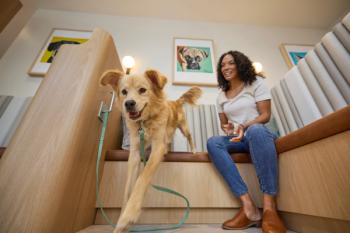
One site, two facilities, two project monitors
Setting goals for saving and developing a plan early helped these doctors develop the perfect new facility for West Park Animal Hospital just six inches away.
For most doctors, the dream to build a hospital comes before the financing. For Drs. Borys Pakush and R. Kane Henderson, the money came first-sort of. "Our first facility was originally a church, which was converted into a veterinary practice in 1961. And we knew when we bought the practice that we'd eventually build a new facility," says Dr. Henderson, co-owner of West Park Animal Hospital and Rehabilitation Center in Cleveland. "So we decided right away how much we'd need to save to start the building process."
The walls of the new facility come within six inches of where the former facility sat (see inset photo). And when they coupled the effective design with high visibility and two access roads, the owners of West Park Animal Hospital didnt have to fear losing clients after the move. In fact, they have grown 30 percent since opening.
The doctors hit that goal within five years. "Next, to get more accurate numbers for how much we should expect to spend, we got a floor plan drawing done and bid the project," says Dr. Pakush. "Then we didn't quit moving. Within two years, we had a new 7,100-square-foot facility, and we've never looked back."
The plan obviously worked for the practice owners. Their new facility has led to a 30 percent increase in revenue growth since they moved in November 2003. And the design earned them a Merit Award in the 2004 Veterinary Economics Design Competition.
Award-winning floor plan
Delays and demolition
After seven years of practice in the 2,600-square-foot former church, with staff members stepping over one another, Drs. Henderson and Pakush had no trouble outlining their must-have features for the new building. Topping their list: improved traffic flow, a larger treatment area with direct access to other essential rooms, and a design that helps control noise and odor. Danylo Kulchytsky, AIA, a local architect, designed the exterior structure and interior aesthetics, and Dan Chapel, AIA, an architect in Little Rock, Ark., served as an architectural consultant and designed the floor plan and heating and cooling system.
With a plan in place, the doctors were ready to get started. But two things stood in the way: biting winter temperatures and dangerous asbestos. "At one point in early January, the temperatures got so cold that the construction crew wasn't able to lay the block for the exterior walls, despite the fact that they had tarps and space heaters surrounding the area," says Dr. Henderson. "The weather didn't rebound for about two months, putting us behind schedule."
Cathedral ceilings in the reception area extend over the exam rooms for a dramatic effect. Pendant lighting, a floor-to-ceiling window, a circular reception desk, and lots of greenery complete the look.
To further complicate matters, the doctors were building on land they owned adjacent to their former facility. In fact, just six inches separate the new facility from the footprint the old one occupied. They continued working in the old building during construction.
With the new building completed, the team moved and planned to start demolition of the old facility. "We were supposed to get an environmental study done on the old building before demolition, to make sure we weren't putting dangerous materials into the landfill," says Dr. Pakush. "We didn't get the study done until we were ready to demolish, which was an oversight on our part. And the inspectors found asbestos, which held us up because we needed an abatement company to handle the removal."
West Park Animal Hospital is the third hospital in Ohio, and one of 60 in the United States, to feature an underwater treadmill for patient rehabilitation.
The close proximity could have been a problem during demolition, says Dr. Henderson. The doctors and construction crew held their breath that the old facility didn't fall into the new building.
Keeping up with two facilities
With the new facility going up right next door, the doctors were able to keep a close eye on the building process. But they also needed to make some adjustments at their current facility to accommodate the nearby construction. To keep inconveniences to a minimum, such as having clients drive through the construction zone, they closed off one entrance to the facility, but kept another entrance open the entire time.
Plan, plan, planâÂÂand follow up
They also bought a portion of a neighbor's parking lot to give themselves more building space, and that addition afforded them another entrance to the parking lot throughout the building process. "During the construction, our team parked on the street to make room for clients," says Dr. Henderson. "But we're very fortunate in the way our property is designed. Because we have two access roads, it was easy for clients to get in and out of our parking lot even with the construction underway."
Each day, the doctors would check out the building progress. "Visiting so often helped us pick up on things that weren't going the way we thought they should and gave us plenty of opportunities to fix those problems," Dr. Pakush says.
The dog ward features terrazzo tile for impermeability and durability and six-inch ceramic baseboards for easy cleaning. Circulating the air from this area directly to the outdoors cuts down on odor.
For example, in the original floor plan, outlets and phone jacks were placed haphazardly. "It was hard to know where we'd really want them when all was said and done," Dr. Henderson says. But as the walls went up and the building took shape, the doctors could place these features more precisely and see flaws that don't show up on a two-dimensional plan, they say.
Just do it!
The doctors' advice to others contemplating building? "Just do it!" says Dr. Pakush. "If you build a new building, your practice will be successful," he says. "We've had a tremendous response from the community in terms of the income the building is generating. We've experienced phenomenal growth since we've been here. Clients will see your dedication, and the new building will increase your enthusiasm, which leads to better medicine and better business." ?
Editors' note: Preparing to build? For more tips, photos, floor plans, and articles-or to get an application for the 2005 Hospital Design Competition-visit
Newsletter
From exam room tips to practice management insights, get trusted veterinary news delivered straight to your inbox—subscribe to dvm360.




